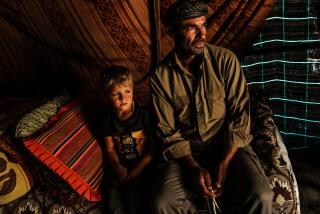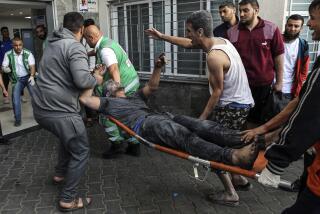Tora Bora: An opportunity missed
- Share via
Eight years ago this month, Osama bin Laden walked out of the Tora Bora mountains in Afghanistan and disappeared into Pakistan. U.S. intelligence agencies have no real idea where he is today, but it is clear that the world’s most wanted man and the terrorist organization he leads have reemerged as a powerful force behind the increasingly deadly insurgencies in Afghanistan and Pakistan.
Three senior Obama administration officials warned last week that Al Qaeda is more dangerous than at any time in the last 18 months. They gave the Senate Foreign Relations Committee a frightening bill of particulars: Al Qaeda is providing training and resources for militants attacking U.S. troops in Afghanistan, assisting suicide bombers in Pakistan and helping extremists plot new attacks on India. Secretary of State Hillary Rodham Clinton described Bin Laden’s Al Qaeda as a “syndicate of terrorism.” Underscoring the danger, she said the terrorists are seeking nuclear weapons.
If we had captured or killed Bin Laden, the world would look very different today. His death or imprisonment would not have eliminated the worldwide extremist threat, but our failure to finish the job represents a lost opportunity that altered the course of the conflict in Afghanistan and the future of international terrorism. It left the American people more vulnerable, and it inflamed the strife that now threatens to engulf Pakistan and Afghanistan.
History is filled with examples demonstrating that terrorist organizations are invariably much stronger with their charismatic leaders than without them. The capture of Abdullah Ocalan in 1999 weakened the Kurdistan Workers Party in Turkey, and the imprisonment of Abimael Guzman in 1992 had a similar effect on Peru’s Shining Path.
The failure to get Bin Laden was not inevitable. By early December 2001, he and his deputy, Ayman Zawahiri, were cornered in a complex of caves and tunnels carved into the rugged terrain of eastern Afghanistan, just a few miles from the border with Pakistan. They endured days of relentless bombing by U.S. aircraft, and Bin Laden clearly expected to be overrun any day by American troops and their Afghan allies. According to Steve Coll’s excellent book on the Bin Laden family, the Al Qaeda leader wrote his will on Dec. 14.
As a recent report by the majority staff of the Foreign Relations Committee made clear, there is no longer any dispute over whether Bin Laden was at Tora Bora. CIA and Delta Force commanders on the scene told the staff that he was there and described intercepting his voice on radio communications. Most authoritatively, Bin Laden’s presence was confirmed by the official history of the U.S. Special Operations Command, which oversees Delta Force, the Green Berets, Navy SEALs and similar special forces. “All source reporting corroborated his presence on several days from 9-14 December,” said the unclassified version of the history, which was published with little notice in 2007.
The final assault that Bin Laden feared never came. Fewer than 100 U.S. special operations commandos were at Tora Bora, not enough to defeat the entrenched Al Qaeda fighters. Calls for reinforcements were rejected. So were requests for U.S. troops to block the exit routes to sanctuary in Pakistan a few miles away. The vast array of U.S. military power was kept on the sidelines by senior commanders who entrusted one of the primary objectives of the war to airstrikes and unreliable Afghan and Pakistani allies.
Military analysts estimate it would have taken only 2,000 or so American troops to accomplish the mission. Most would have been deployed on the southern side of Tora Bora to block escape routes to Pakistan. About 500 would have carried out the final assault from the north. We had enough troops in or near Afghanistan at the time, and they were trained for this type of unconventional fight in rugged terrain.
More than 1,000 members of two Marine expeditionary units were not far away in Kandahar, but their commander’s request to move to Tora Bora to encircle Bin Laden was rejected. Roughly the same number of troops from the Army’s 10th Mountain Division was split between southern Uzbekistan and Bagram air base, a short helicopter ride from Tora Bora. Instead, Gen. Tommy Franks left the job to a motley collection of Afghan militiamen and Pakistani Frontier Corps paramilitary fighters who never showed up.
Franks and his boss, Secretary of Defense Donald H. Rumsfeld, were determined to succeed in Afghanistan with a light footprint. They justified limiting the number of U.S. troops by saying they wanted to avoid stirring up anti-American sentiment and creating a protracted insurgency. Unfortunately, in failing to get Bin Laden, we wound up with exactly what we had hoped to avoid in Afghanistan -- and a virulent insurgency across the border in Pakistan, a nuclear-armed ally.
Getting Bin Laden at Tora Bora would have been dangerous, and success was not guaranteed. Failing to try meant that we had no chance for success. Our men and women in uniform have been paying the price for eight years and, as 30,000 more of them are preparing to finish the job, we must all remember that we can’t ensure our national security by turning our backs on enemies who have sworn to destroy us.
John Kerry (D-Mass.) chairs the Senate Foreign Relations Committee.
More to Read
Sign up for Essential California
The most important California stories and recommendations in your inbox every morning.
You may occasionally receive promotional content from the Los Angeles Times.










